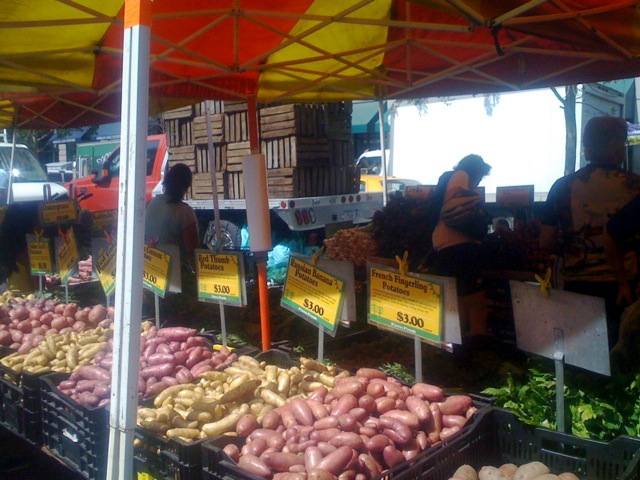
reference-image, l
(article, Leda Meredith)
[%pageBreakSettings nobreak=true] The stereotype of someone who can afford to eat local, organic ingredients is a foodie with lots of free time and disposable income. That’s not me. I try to eat mostly foods raised sustainably within 250 miles of where I live, but I don’t have time or cash to spare. What I’ve learned is that a local, organic diet can be expensive, but it doesn’t have to be. For example, from June to November, I get all of my fruits and vegetables for free (more about how to do that below). It’s worth remembering that those seemingly cheap prices for conventionally raised foods are an illusion, because you pay the price at tax time, via government subsidies that support chemical agriculture but not small farms practicing sustainable agriculture. I wish there were a tax deduction for locavores who don’t eat the conventional foods subsidized by those taxpayer dollars, but since there isn’t, here are a few of the ways I’ve discovered to eat local on a budget. [[list(culinate8). #(clear n1). Grow or forage your own grub. Gardening is the ultimate local-foods diet, matched only by foraging for wild edible plants. There are delicious wild fruits and vegetables as well as gourmet mushrooms growing right at your feet, even if you live in the city. Usually overlooked as “weeds,” these free foods are yours once you learn some simple but essential identification skills. Sign up for one of the wild-edibles classes offered nationwide, and you’ll soon be safely harvesting the free food growing all around you. #(clear n2). No room, time, or interest in gardening? Get involved with a CSA. If you can volunteer a few hours a week for a few weeks each year, you may be able to get a community-supported agriculture (CSA) share totally free. CSAs depend on a core group of volunteers who are responsible for tasks that range from bookkeeping to website maintenance to communicating with the farmer. In exchange, most CSAs offer core members discounted or free vegetable shares, depending on how much time they put in. (I volunteer five hours a week as site coordinator for my CSA for eight weeks, in exchange for which I get my vegetable share for free. If I put in more weeks than that, I also get my fruit share for free.) Many CSAs also offer discounted shares to low-income families, and most CSAs accept EBT payments at a discounted membership rate. Ask if discounted shares are available at your local CSA, and be prepared to show some proof of your income status to qualify. #(clear n3). Even with a CSA, you might need extras. Be a savvy shopper at the farmers' market. Walk through the entire farmers' market before you buy anything, checking to see what looks the best and which stalls have the lowest prices. Often there's a huge difference in price for the same vegetable between one farm’s stall and the next. #(clear n4). Pay attention to peak seasonality. Each crop has a season and a peak season. "Peak season" is when the produce is both tastiest and cheapest. For example, tomatoes appear at my farmers’ markets in June, but aren’t really at their tastiest or most affordable until August. #(clear n5). [%image reference-image float='clear right' width=350 caption="Some of Leda Meredith's homemade canned goods."] Put up your harvest (or bulk purchases) for the cold months. By [/mix/dinner_guest?author=1378 "freezing, canning, pickling, or otherwise preserving summer's bounty," newpage=true] my locavore meals in wintertime are varied and delicious, and they balance the budget of what I spend during the warm months. The strawberries I froze when they were at their most luscious (and cheapest) become breakfast smoothies in January; the ratatouille I made with summer squash and eggplant becomes a quick pasta sauce long after squash and eggplant season is over. So pick up a few food-preservation skills, not only to add interest and nutrition to your winter diet but also to keep costs down. #(clear n6). Waste not, want not. Instead of throwing apple cores and peels into the compost, I stockpile them in the freezer to make homemade apple vinegar and to use as pectin for jellies and jams. I also use my freezer to save vegetable trimmings and poultry, meat, and fish bones, which I turn into delicious stocks that later become soups and sauces. Carrot leaves, onion skins, parsley stems, and the tough green parts of leeks are among the usually thrown-out parts of vegetables that are great in stock. #(clear n7). Eat fewer animal foods. Even sustainably, humanely raised animals and animal products require a heftier input of resources and labor than plants do. That's why they're the most expensive items at the farmers’ market. By eating vegetarian meals several times a week, even if you enjoy your dairy, eggs, or meat on the other days, you’ll significantly reduce your food costs. #(clear n8). Eat at home. And no, takeout doesn’t count. If your lifestyle till now has included more than one restaurant, takeout, or delivery meal a week, then cooking at home will definitely save you money. ]] p(bio). Leda Meredith is the author of the new book The Locavore's Handbook.

reference-image, l

feature-image, l